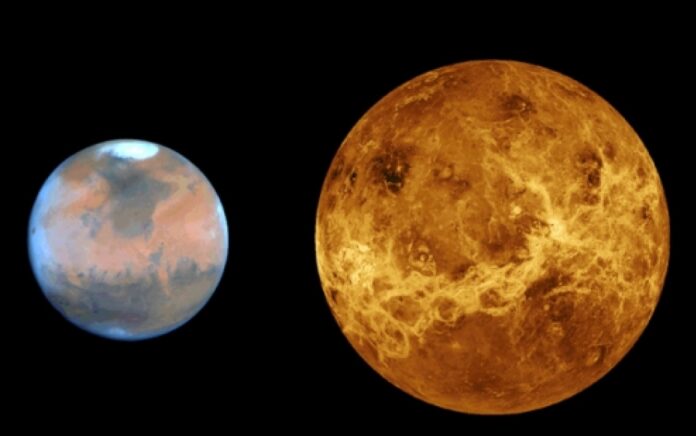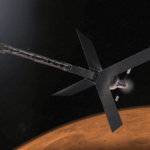Mars and Venus couldn’t be more different as neighbours to Earth. Mars is a cold place receiving less than half the solar radiation that strikes Earth. Its inhospitable atmosphere is 1% the density of ours. A day on Mars lasts about 24.5 hours and its axial tilt is slightly more inclined than Earth which produces seasonal variations similar to ours. Like Earth, Mars has polar ice caps because it is cold at the poles. But a summer’s day at the equator sees temperatures peak at 20 Celsius (68 Fahrenheit). Nighttime temperatures because of the thin atmosphere fall to minus 70 Celsius (-100 Fahrenheit) or more.
Venus is a hothouse with day and nighttime temperatures about equal at 450 Celsius (842 Fahrenheit), and an atmosphere 90 times denser than Earth. A day on Venus lasts almost as long as the planet’s year which means it is in tidal lock similar to the way the Moon presents the same face to us here on Earth. Venus, however, unlike the Moon has its thick atmosphere to evenly distribute heat generated from the solar radiation that falls on it.
Two very dissimilar planets and yet both intriguingly presenting chemical evidence that signifies past or present life.
In the case of Venus, the recent detection of the chemical phosphine (PH3) in the planet’s atmosphere suggests there may be microbial life floating high above the surface in more temperate climes. On Earth, phosphine is considered a biomarker, in other words, an indicator of life. Unless Venus produces chemical reactions dissimilar to those found on our planet, the discovery of PH3 is pretty exciting and causing NASA, the U.S. space agency, to rethink its plans for planetary exploration. A U.S. space probe hasn’t visited Venus since 1978.
In the case of Mars, the search for evidence of past life, and suitable conditions for it, continue with various orbiters, landers, and rovers having been sent since the first NASA Mariner 4 flyby back in 1965. The latest discovery linked to past life is a hint that organic salts may be present in the soil and surface rocks being analyzed by the NASA Curiosity onboard sample analysis lab (SAM). Organic salts would be pretty strong evidence of past microbial life. Preliminary results of samples are reported in the journal JGR Planets, published on March 30, 2021. In the journal article summary, it notes that any remaining organic salts still found on the Martian surface would be degraded by solar radiation bombardment. Traces discovered by SAM at the surface, however, likely suggests a much larger subsurface presence.
With planetary missions almost exclusively focused on Mars for the last few decades, Venus has been relegated to what the Russian space program calls their planet. Back in September of last year, Dmitry Rogozin made that claim arguing only Russia had successfully landed on the Venusian surface. But it wasn’t Russia. It was the former Soviet Union that sent a number of Venera spacecraft to explore the planet’s atmosphere and surface. Finally, in 1970 after several failures, the Venera 7 landed on the surface sending back pictures and data for 23 minutes before succumbing to the heat. Rogozin in his September claim to Venus noted that the Russian space program had plans to return with no specific launch window announced.
Meanwhile, the discovery of PH3 has galvanized NASA to create two new missions to Venus. The space agency back in 2019 had launched a competition for scientific mission proposals to study Venus. Of the four submissions, NASA picked two finalists:
- DAVINCI+ is an acronym for Deep Atmosphere Venus Investigation of Noble gases, Chemistry, and Imaging. DAVINCI+ will study Venus’ atmosphere and look for evidence of a past planetary ocean. It will provide high-resolution imaging of the planet’s surface from a descent sphere that will enter the planet’s atmosphere to study geological features that appear to once have been continents that would confirm past plate tectonics. It will measure noble gases and other elements while studying the origin and past history of the atmosphere and should be able to detect the presence of PH3.
- VERITAS is an acronym for Venus Emissivity, Radio Science, InSAR, Topography, and Spectroscopy. VERITAS is n orbiter equipped with synthetic aperture radar to chart the surface of nearly the entire planet and create a 3D topographic model. It will look for evidence of active plate tectonics and volcanism. Its infrared mapper will determine the composition of the planet’s surface rocks. From VERITAS’ findings NASA’s scientists hope to get a better understanding of the runaway greenhouse effect that made the planet what it is today.
The launch window for these two NASA missions will be between 2028 and 2030. Budgeting for both is in place.
















